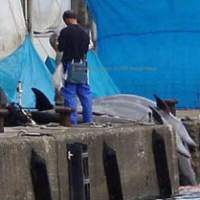The photos accompanying this article were shot covertly despite escalating intimidation by members of the Isana Fishery Union in Taiji, Wakayama Prefecture, who appear to be increasingly fearful that continuing publicity in Japan and abroad will threaten their widely condemned but profitable annual dolphin slaughter.
This year, with special dispensation from the government's Fisheries Agency in Tokyo, those conducting the Isana Union's oikomi (drive fisheries) were allowed to begin their killings on Sept. 1 — a month earlier than normal — and to continue as usual until March 31. It means more money in the bank for those in Taiji who do their worst with lances and long-bladed knives. More money, too, for those involved in the subsequent butchering, packing and retailing of the toxic dolphin meat that far exceeds Japan's legal levels of mercury concentration.
But why should those Taiji killers care? This year the official annual quota has been upped by 88 animals, to a total of 2,468. The creatures' meat is even included in school meals, and though the government knows full well it is toxic — up to 87 times the permitted level of methyl mercury was found in a joint Japanese/New Zealand 2005 academic study of samples bought from shops (see JT, Nov.1, 2006) — it seems it will do nothing now, perhaps preferring some scapegoating and deep bowing when awful human afflictions arise in the future. And as for Japan's meek vernacular media, well don't wait for them to raise a stink.
Camera scuffle
The photos here were taken by Nigel Barker, a longtime Australian resident of Taiji, who said he was attacked by a supporter of the Isana Union who tried to grab his camera. Undeterred, he managed to capture these images of five bottlenose dolphins awaiting butchering on the dock at Taiji harbor on Sept. 14, and a truckload of backbones from pilot whales that a few hours earlier had been swimming in the "killing cove," into which they were driven from the open sea.
According to eyewitness accounts, to date this year, the killing — which is conducted in a national park — has accounted for 95 cetaceans, comprising 45 Rissos dolphins, 18 bottlenose dolphins and 32 pilot whales, one of the largest dolphin species. Five other dolphins were reportedly selected for lucrative sale as show performers. But there is still time for an awful lot more toxic bloodletting before this extended season ends in March.




